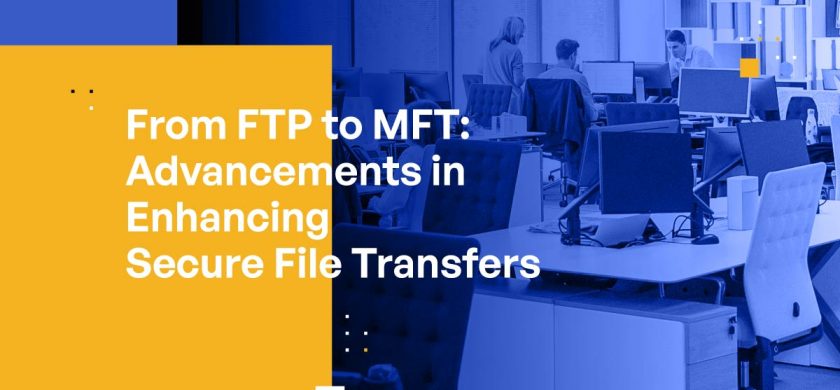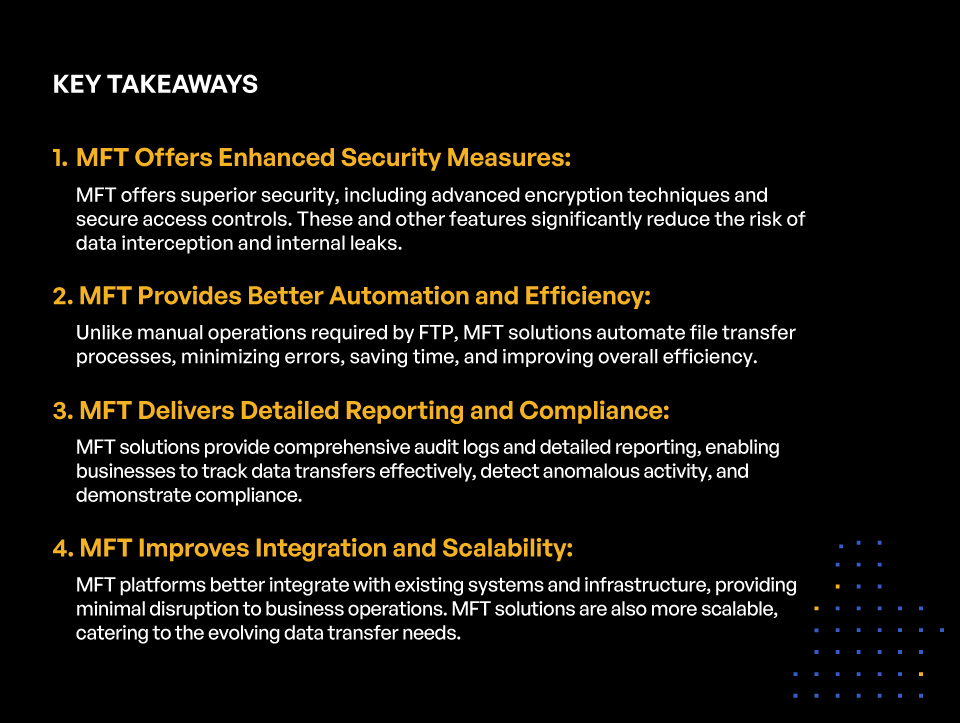
From FTP to Managed File Transfer: Advancements in Enhancing Secure File Transfers
The transfer of files, documents, and data is a common and critical business process in many organizations. Initial protocols such as File Transfer Protocol (FTP) have been essential for enabling this exchange of information over a network. However, as business operations and their supply chains have grown and become more complex, the need for more robust, secure, and managed file transfer solutions has grown. Enter Managed File Transfer (MFT).
Managed file transfer technology builds upon the basic functionality of file transfer, providing enhanced features for better control, security, and management of data transfers. It goes beyond the rudimentary nature of file transfer protocol by offering additional capabilities such as automation, detailed reporting, auditing, and encryption. As we move further into a business environment where data protection and compliance are top priorities, graduating from FTP to MFT becomes a crucial transition for businesses of all sizes.
Still debating between FTP and managed file transfer? Here are six reasons why managed file transfer is better than FTP .
In this post, we’ll take a closer look at how managed file transfer has eclipsed file transfer protocol and explore what makes managed file transfer a modern (read: more efficient and secure) form of file transfer.
Building Upon Basic File Transfer Functionality: The Genesis of Managed File Transfer
File transfer protocol has long been the standard for sending files over the internet. Although initially heralded for its efficiency, FTP has several drawbacks, especially from a security standpoint. File transfer protocol is not encrypted, leaving data vulnerable to interception during transfer. There are also concerns about the lack of file delivery confirmation and issues regarding large file transfers. Furthermore, file transfer protocol requires manual operation, which may be inefficient and error–prone in large–scale business operations.
Managed File Transfer emerged as a response to these challenges, enhancing basic file transfer capabilities to meet the changing needs of businesses. The primary objective of managed file transfer is to simplify, streamline, and secure the exchange of data between systems, individuals, and organizations. MFT solutions come equipped with capabilities that aid in automation, monitoring, reporting and analytics, and security measures—features that are often absent in traditional file transfer protocol solutions.
Managed File Transfer and Enhanced Security
One of the main advantages of managed file transfer over file transfer protocol is its superior security provisions. Businesses are often targets of cyber threats and data breaches, with attackers always on the lookout for vulnerabilities to exploit. This is where managed file transfer enters the chat. Managed file transfer platforms use advanced data encryption techniques to protect files in transit and at rest, making unauthorized data interception virtually impossible.
Moreover, managed file transfer solutions offer secure folders and access controls, allowing administrators to define user roles and access rights, enhance identity verification, and maintain a secure file–sharing environment. This level of control effectively mitigates the risk of internal data leaks. Taken together, these managed file transfer features provide an enhanced security framework that is miles ahead of file transfer protocol’s rudimentary protection measures.
Achieve Automation and Efficiency with Managed File Transfer
Another area where managed file transfer has surpassed file transfer protocol is in automation and efficiency. File transfer protocol typically requires manual operation for transferring files, which can be laborious and prone to human error, particularly when dealing with an extensive number of files or complex transfer workflows. Alternatively, managed file transfer software is designed to automate these processes.
KEY TAKEAWAYS

KEY TAKEAWAYS
- MFT Offers Enhanced Security Measures:
MFT offers superior security, including advanced encryption techniques and secure access controls. These and other features significantly reduce the risk of data interception and internal leaks. - MFT Provides Better Automation and Efficiency:
Unlike manual operations required by FTP, MFT solutions automate file transfer processes, minimizing errors, saving time, and improving overall efficiency. - MFT Delivers Detailed Reporting and Compliance:
MFT solutions provide comprehensive audit logs and detailed reporting, enabling businesses to track data transfers effectively, detect anomalous activity, and demonstrate compliance. - MFT Improves Integration and Scalability:
MFT platforms better integrate with existing systems and infrastructure, providing minimal disruption to business operations. MFT solutions are also more scalable, catering to the evolving data transfer needs.
A standard MFT solution allows for the creation of predefined workflows to automate routine tasks such as moving, renaming, deleting, and even triggering events based on specific conditions. This automation significantly reduces the manual intervention required, thereby minimizing errors, saving time, and improving overall efficiency. These features make managed file transfer a powerful tool for businesses in managing their file transfers.
Improve Reporting, Auditing, and Compliance with Managed File Transfer
As opposed to file transfer protocol, managed file transfer solutions have robust capabilities for detailed reporting and auditing. These features are critical for businesses that need to track data transfers for regulatory compliance with various industry standards and data privacy laws. Managed file transfer software provides comprehensive audit logs of all file transfer activities, which can be invaluable during an audit or for detecting anomalous activity. Detailed reports also provide businesses with important insights into their data transfer activities, helping them optimize their processes and improve efficiency.
Managed File Transfer software also excels in assisting organizations with regulatory compliance. Different industries have different regulatory standards, such as the Health Insurance Portability and Accountability Act (HIPAA) for healthcare and the Payment Card Industry Data Security Standard (PCI DSS) for companies that handle card payments. MFT solutions can be configured to ensure file transfers comply with these regulations, providing an additional layer of security and peace of mind for businesses.
Increase Integration and Scalability with Managed File Transfer
Managed file transfer solutions also offer superior integration and scalability compared to file transfer protocol. MFT platforms can easily integrate with existing systems and infrastructure, ensuring a smooth transition with minimal disruption to business operations. This integration extends to various applications, databases, and even cloud–based services, allowing for the seamless exchange of data across multiple platforms and systems.
When it comes to scalability, managed file transfer once again exceeds what file transfer protocol has to offer. As businesses grow, their data transfer needs become more complex and voluminous. MFT solutions are designed to scale with these growing requirements, catering to everything from small file transfers to handling massive data sets. This scalability, combined with the increased efficiency brought about by automation, makes managed file transfer a future–proof investment for businesses.
Kiteworks Helps Organizations Move Beyond FTP to Secure Managed File Transfer
In a world where data transfer forms the backbone of many business operations, the transition from FTP to MFT has become an essential move. Managed file transfer provides enhanced security provisions, robust reporting and auditing capabilities, superior integration and scalability, and a host of other features that make it an inherently superior alternative to file transfer protocol.
By offering advanced levels of control and automation, managed file transfer can significantly enhance the efficiency of file transfers, all while ensuring the highest levels of data security. As businesses become more digital and data–driven, the need for robust, secure, and efficient file transfer mechanisms like managed file transfer will only grow. Thus, making the switch from file transfer protocol to managed file transfer is not only a smart decision but a necessary one for businesses to operate efficiently and securely in this data–driven era.
The Kiteworks Private Content Network, a FIPS 140-2 Level validated secure file sharing and file transfer platform, consolidates email, file sharing, web forms, SFTP and managed file transfer, so organizations control, protect, and track every file as it enters and exits the organization.
Kiteworks secure managed file transfer provides robust automation, reliable, scalable operations management, and simple, code-free forms and visual editing. It is designed with a focus on security, visibility, and compliance. In fact, Kiteworks handles all the logging, governance, and security requirements with centralized policy administration while a hardened virtual appliance protects data and metadata from malicious insiders and advanced persistent threats. As a result, businesses can transfer files securely while maintaining compliance with relevant regulations
Kiteworks secure managed file transfer supports flexible flows to transfer files between various types of data sources and destinations over a variety of protocols. In addition, the solution provides an array of authoring and management functions, including an Operations Web Console, drag-and-drop flow authoring, declarative custom operators, and the ability to run on schedule, event, file detection, or manually.
Finally, Kiteworks Secure MFT Client provides access to commonly-used repositories such as Kiteworks folders, SFTP Servers, FTPS, CIFS File Shares, OneDrive for Business, SharePoint Online, Box, Dropbox, and others.
In total, Kiteworks secure managed file transfer provides complete visibility, compliance, and control over IP, PII, PHI, and other sensitive content, utilizing state–of–the–art encryption, built-in audit trails, compliance reporting, and role-based policies.
To learn more about Kiteworks’ secure managed file transfer capabilities, schedule a custom demo today.
Additional Resources
- Blog Post 6 Reasons Why Managed File Transfer is Better than FTP
- Blog Post Secure Managed File Transfer: Which Solution is Best for Your Business?
- Video Kiteworks Secure Managed File Transfer: The Most Secure and Advanced Managed File Transfer Solution
- Blog Post Navigate Complex Financial Regulations With Secure Managed File Transfer
- Blog Post Eleven Requirements for Secure Managed File Transfer